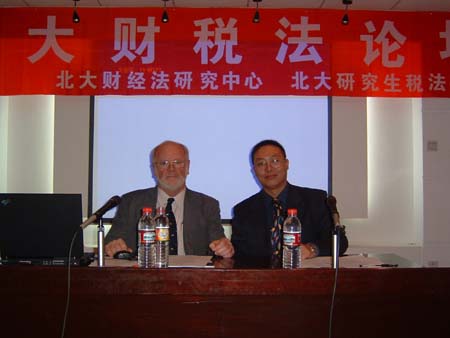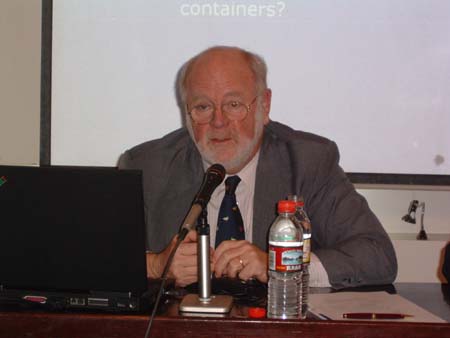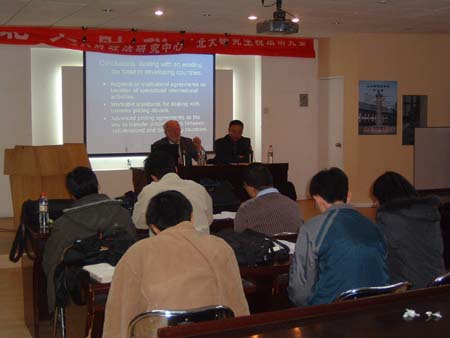The Eroding Tax Bases of Developing Countries?
A Special Presentation at Peking University
Beijing, China
December 6, 2004
By Charles R. Irish, Director
East Asian Legal Studies Center
Volkman-Bascom Professor of Law
University of Wisconsin
Madison, USA Charles Irish教授和张智勇研究员
Charles Irish教授和张智勇研究员
1. The form of the title is significant. Note that it is stated as a question, not a fact.
A. What is proposed here is largely a hypothesis: that as economic activity becomes increasingly globalized, the share of tax revenues going to developing countries is declining while the share flowing into the industrialized countries is increasing.
B. A corollary to this hypothesis is that the increased mobility of capital enables many economic activities to escape taxation through the use of tax havens.
2. Taxation of international business – two preliminary issues:
A. What are the major taxes on international business activities?
(i) Customs duties – historically and after WTO.
(ii) Indirect taxes, such as VAT and excise taxes.
(iii) Direct taxes, principally in the form of taxes on income.
B. How are tax revenues from international business divided among the countries in which that business is conducted?
(i) The source and residence principle in international taxation.
(ii) Source and residence between countries at similar levels of economic development.
(iii) Source and residence between industrialized countries and developing countries. Charles Irish教授在发言
Charles Irish教授在发言
3. Taxation of international shipping and air transport services.
A. Has the globalization of economic activities made these services more or less important?
B. Special issues in the taxation of shipping and air transport services.
(i) Example: Federal Express delivers goods from Beijing to Tokyo and New York and brings goods from New York to Tokyo and Beijing.
(ii) Example: Northwest Airlines carries passengers to and from Minneapolis to Tokyo and Shanghai, Beijing, and Guangzhou.
(iii) Shipping is even more difficult.
(iv) What about the profit element in containers?
4. E-commerce.
A. Has the globalization of economic activities made these services more or less important?
B. Special issues in the taxation of E commerce.
(i) Electronic delivery of digital products?
(ii) Profits embedded in digital services? Sponsored links on Google, e.g.
(iii) Outsourcing?
5. Financial services.
A. Has the globalization of economic activities made commercial banking operations more or less important?
B. Has the globalization of economic activities made investment banking services more or less important?
C. Special issues in the taxation of financial services.
(i) The mobility of capital creates acute problems for national tax collectors.
(ii) Interest expenses are fungible.
(iii) International service fees are difficult to verify.
6. Manufacturing.
A. Has the globalization of economic activities made manufacturing more or less important?
B. Tax issues with the elements of manufacturing.
(i) Intra-firm transfers of component parts.
(ii) Licensing of intangible property.
(iii) Management services fees.
(iv) Home office expenses. 台下座无虚席
台下座无虚席
7. The special problem of transfer pricing.
A. Transfer pricing examples:
(i) Haier sells refrigerators in the U.S. through a wholly owned U.S. subsidiary (“ US Sub”). Suppose the manufacturing cost of a refrigerator is Rmb 600, all of the manufacturing costs are in China, and the sales price in the U.S. is Rmb 2000. If Haier sets the price at which it transfers the refrigerator to US Sub at Rmb 1000 (the “transfer price”), note the implications for tax collection in China and the U.S.
1. What happens if Haier sets the price at Rmb 601?
2. What happens if Haier sets the price at Rmb 1999?
3. What happens if Haier creates an international sales subsidiary in the British Virgin Islands (“BVI Sub”) and Haier sells to the BVI Sub for Rmb 601 and the BVI Sub sells to the US Sub for Rmb 1999?
(ii) LG, a Korean company, has a joint venture in China (“LG JV”). LG JV has profits of Rmb 100 million. LG JV pays LG Rmb 25 million as a “management fee.” LG JV also pays LG Rmb 30 million for licenses of patents for use in China.
B. Transfer pricing standards – the arm’s length principle.
C. Transfer pricing administration in industrialized countries.
8. Conclusions: suggestions for dealing with an eroding tax base in developing countries.
A. Regional or multilateral agreements on taxation of specialized international activities.
B. Workable standards for dealing with transfer pricing abuses.
C. Advanced pricing agreements as the key to transfer pricing issues between industrialized and developing countries.



